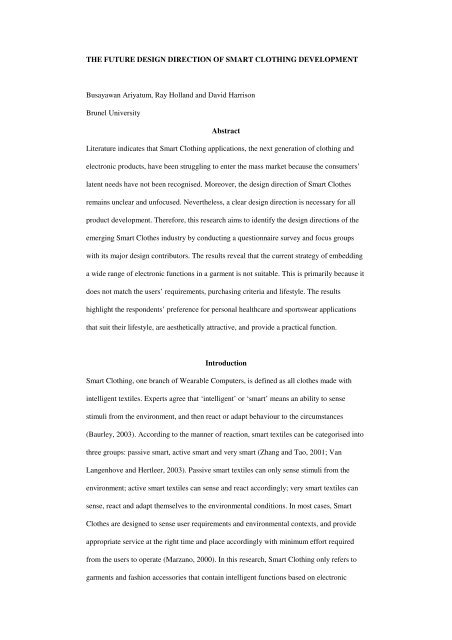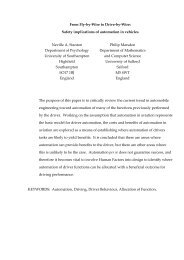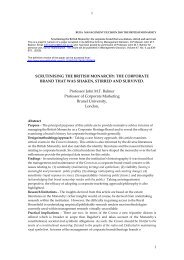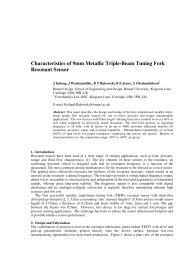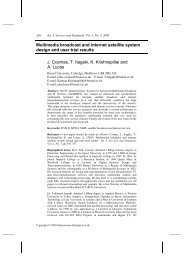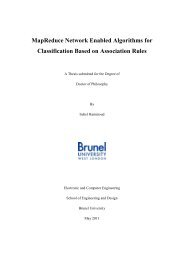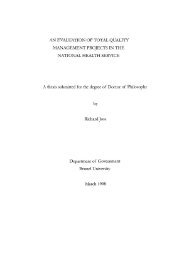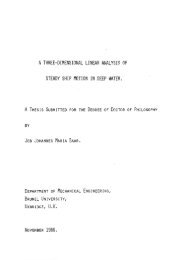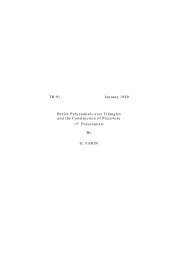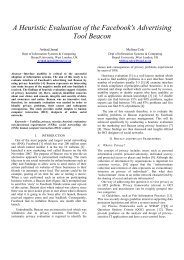the future design direction of smart clothing ... - Brunel University
the future design direction of smart clothing ... - Brunel University
the future design direction of smart clothing ... - Brunel University
Create successful ePaper yourself
Turn your PDF publications into a flip-book with our unique Google optimized e-Paper software.
THE FUTURE DESIGN DIRECTION OF SMART CLOTHING DEVELOPMENT<br />
Busayawan Ariyatum, Ray Holland and David Harrison<br />
<strong>Brunel</strong> <strong>University</strong><br />
Abstract<br />
Literature indicates that Smart Clothing applications, <strong>the</strong> next generation <strong>of</strong> <strong>clothing</strong> and<br />
electronic products, have been struggling to enter <strong>the</strong> mass market because <strong>the</strong> consumers’<br />
latent needs have not been recognised. Moreover, <strong>the</strong> <strong>design</strong> <strong>direction</strong> <strong>of</strong> Smart Clo<strong>the</strong>s<br />
remains unclear and unfocused. Never<strong>the</strong>less, a clear <strong>design</strong> <strong>direction</strong> is necessary for all<br />
product development. Therefore, this research aims to identify <strong>the</strong> <strong>design</strong> <strong>direction</strong>s <strong>of</strong> <strong>the</strong><br />
emerging Smart Clo<strong>the</strong>s industry by conducting a questionnaire survey and focus groups<br />
with its major <strong>design</strong> contributors. The results reveal that <strong>the</strong> current strategy <strong>of</strong> embedding<br />
a wide range <strong>of</strong> electronic functions in a garment is not suitable. This is primarily because it<br />
does not match <strong>the</strong> users’ requirements, purchasing criteria and lifestyle. The results<br />
highlight <strong>the</strong> respondents’ preference for personal healthcare and sportswear applications<br />
that suit <strong>the</strong>ir lifestyle, are aes<strong>the</strong>tically attractive, and provide a practical function.<br />
Introduction<br />
Smart Clothing, one branch <strong>of</strong> Wearable Computers, is defined as all clo<strong>the</strong>s made with<br />
intelligent textiles. Experts agree that ‘intelligent’ or ‘<strong>smart</strong>’ means an ability to sense<br />
stimuli from <strong>the</strong> environment, and <strong>the</strong>n react or adapt behaviour to <strong>the</strong> circumstances<br />
(Baurley, 2003). According to <strong>the</strong> manner <strong>of</strong> reaction, <strong>smart</strong> textiles can be categorised into<br />
three groups: passive <strong>smart</strong>, active <strong>smart</strong> and very <strong>smart</strong> (Zhang and Tao, 2001; Van<br />
Langenhove and Hertleer, 2003). Passive <strong>smart</strong> textiles can only sense stimuli from <strong>the</strong><br />
environment; active <strong>smart</strong> textiles can sense and react accordingly; very <strong>smart</strong> textiles can<br />
sense, react and adapt <strong>the</strong>mselves to <strong>the</strong> environmental conditions. In most cases, Smart<br />
Clo<strong>the</strong>s are <strong>design</strong>ed to sense user requirements and environmental contexts, and provide<br />
appropriate service at <strong>the</strong> right time and place accordingly with minimum effort required<br />
from <strong>the</strong> users to operate (Marzano, 2000). In this research, Smart Clothing only refers to<br />
garments and fashion accessories that contain intelligent functions based on electronic
technologies. Smart Clo<strong>the</strong>s and Wearable Computers bring a large number <strong>of</strong> product<br />
opportunities; as Venture Development Corporation estimates that it will grow more than<br />
50% each year through to 2006 and its shipment will reach 563 million dollars in 2006<br />
(Broersma, 2002). Never<strong>the</strong>less, this market research emphasises that <strong>the</strong> true potential <strong>of</strong><br />
Smart Clothing can only be reached if improvements are made in consumer-based products.<br />
Although great deal <strong>of</strong> improvements are made in terms <strong>of</strong> technical aspects, Smart Clo<strong>the</strong>s<br />
are struggling to gain social acceptance because <strong>the</strong>y fail to follow <strong>the</strong> norms <strong>of</strong> <strong>the</strong> social<br />
interaction (Edwards, 2003). In order to improve a <strong>design</strong> process, Krose (2002) stresses<br />
that it is unavoidable to study an outcome <strong>of</strong> <strong>the</strong> process or a product and its nature.<br />
However, Uotila, et al (2003) note that Smart Clothing is an entirely new product and <strong>the</strong><br />
users’ needs have not been realised. Since <strong>the</strong> <strong>design</strong> <strong>direction</strong> remains unclear, it is difficult<br />
to improve product development and commercialisation. This situation expresses a pressing<br />
need for a clear <strong>design</strong> approach and better understanding <strong>of</strong> <strong>the</strong> consumers. Thus, this<br />
research aims to identify <strong>future</strong> <strong>direction</strong>s in <strong>the</strong> <strong>design</strong> approach to Smart Clothing that<br />
match user pr<strong>of</strong>ile and lifestyle. Since users are largely unaware <strong>of</strong> Smart Clothing products,<br />
<strong>the</strong> investigation focuses on <strong>the</strong>ir lifestyle and vision <strong>of</strong> <strong>the</strong> <strong>future</strong>. In addition, <strong>the</strong><br />
purchasing criteria <strong>of</strong> <strong>the</strong> related fields, e.g. electronic and apparel goods are examined.<br />
Background Research<br />
The research structure reported for this paper is based on <strong>the</strong> findings <strong>of</strong> <strong>the</strong> previous<br />
investigations, namely a literature review (see Ariyatum and Holland, 2003) and in-depth<br />
interviews with key developers within <strong>the</strong> Smart Clothing field (see Ariyatum, Holland and<br />
Harrison, 2004). The results <strong>of</strong> <strong>the</strong> previous studies are briefly summarised below.<br />
Result <strong>of</strong> Literature Review<br />
The literature review was conducted to identify <strong>the</strong> <strong>design</strong> evolution and trends in Smart<br />
Clothing development. Information as well as images <strong>of</strong> <strong>the</strong> current research and<br />
development projects from different teams were collected and put on a timeline<br />
chronologically (see figure 1). Results from <strong>the</strong> comparison and analysis conducted with<br />
<strong>the</strong> current projects reveal that <strong>the</strong> <strong>design</strong> evolution was divided into three periods.
1. In <strong>the</strong> first period, 1980s to 1997, <strong>the</strong> <strong>design</strong> approach was regarded as technology-<br />
driven, since most research and developments focused on Wearable Computing and<br />
applications <strong>of</strong> advanced technologies (see, for example, Mann, 1996; Orth, Post and<br />
Cooper, 1998). For instance, Randell (2001) predicted that integrating sensing and<br />
displaying technologies could bring a lot <strong>of</strong> opportunities to textile manufacturers.<br />
Thus, <strong>the</strong> researcher and his team developed ‘CyberJacket’, which integrated location<br />
sensors (GPS), displays, etc, to demonstrate <strong>the</strong> possibilities. Never<strong>the</strong>less, this<br />
prediction was based on <strong>the</strong> trends <strong>of</strong> miniaturisation <strong>of</strong> electronic devices not<br />
consumer requirements. Whe<strong>the</strong>r people carry electronic devices around means <strong>the</strong>y<br />
want <strong>the</strong>se devices to be part <strong>of</strong> <strong>the</strong>ir clo<strong>the</strong>s and operate unobtrusively without <strong>the</strong> user<br />
being conscious <strong>of</strong> it is debatable. Fur<strong>the</strong>rmore, <strong>the</strong> inputs from fashion <strong>design</strong> and<br />
business were neglected. Therefore, <strong>the</strong> products were more ‘portable’ ra<strong>the</strong>r than<br />
‘wearable’, for example, MIT’s wearable computer (O’Mahony, 2002).<br />
2. In <strong>the</strong> second period, 1998 to 2000, <strong>the</strong> awareness and involvement <strong>of</strong> <strong>the</strong> fashion and<br />
textile sector significantly rose. Consequently, <strong>the</strong> number <strong>of</strong> <strong>the</strong> collaborative projects<br />
between electronic and fashion fields rapidly increased, for example, <strong>the</strong> Cyberia<br />
project (Rantanen, et al, 2000). Moreover, experts in textile and <strong>clothing</strong> started to<br />
create <strong>the</strong>ir own research and development (Braddock and O'Mahony, 1998). For<br />
instance, <strong>the</strong> Haute Couture <strong>design</strong>er, Alexandra Fede, worked with Du Pont and<br />
Mitsubishi Materials Corporations to develop <strong>the</strong> collections incorporating advanced<br />
technologies. Although <strong>the</strong> applications became more wearable, most outcomes were<br />
still prototype garments, as <strong>the</strong> technologies were underdeveloped, e.g. Philips and<br />
Levi’s ICD+ jacket (Meoli and May-Plumlee, 2002), and SCOTT eVast (Forman,<br />
2001). Besides, product concepts, e.g. having optical fibre screen on clo<strong>the</strong>s (see<br />
Gould, 2003; France Telecom, 2003), did not match requirements <strong>of</strong> <strong>the</strong> mass market.<br />
3. In <strong>the</strong> third period, 2001 to 2004, <strong>the</strong> number <strong>of</strong> Smart Clo<strong>the</strong>s available in <strong>the</strong> market<br />
increased dramatically, e.g. The North Face’s MET5 TM jacket (Ward, 2001), Adidas’s<br />
<strong>smart</strong> shoes (Momphard, 2004) and GapKid’s sweatshirts with embedded FM radio
(CNN, 2004). Multidisciplinary approach and user-centred <strong>design</strong> are widely adopted<br />
by most development teams. Fur<strong>the</strong>rmore, <strong>the</strong> boundary <strong>of</strong> <strong>the</strong> applications expanded<br />
into new areas. For example, Dodson (2003) reports that Northwest Airlines in <strong>the</strong> US<br />
give <strong>the</strong>ir staff a wearable computer to reduce <strong>the</strong> time for <strong>the</strong> check-in.<br />
Nokia presented <strong>the</strong> new wearable range in 2003 and planned to launched <strong>the</strong> products in 1st Nokia presented <strong>the</strong> new wearable range in 2003 and planned to launched <strong>the</strong> products in 1 quarter <strong>of</strong> 2004<br />
st quarter <strong>of</strong> 2004<br />
Mmode Group started in July 2001 and presented Smart Materials Research in September 2001<br />
Pioneer Corporation and fashion companies started Media Fashion Project in March/April 2001<br />
MIT’s MSc <strong>the</strong>sis in intelligent <strong>clothing</strong> field was submitted in June 2000<br />
SOFTswitchTM Ltd. developed and presented SOFTswitchTM SOFTswitch technology<br />
2nd wave France Telecom presented its first functional prototype in May 2000<br />
TM Ltd. developed and presented SOFTswitchTM technology<br />
2nd wave France Telecom presented its first functional prototype in May 2000<br />
Starlab’s i - Wear Intelligent Clothing Consortium started in 1999<br />
Central St. Martins College <strong>of</strong> Art and Design’s started MA Textile Future<br />
MIT Media Lab, IDEO and BMW started project toge<strong>the</strong>r in September 1999<br />
Charmed Technology started Brave New Unwire World Fashion Show<br />
<strong>Brunel</strong> <strong>University</strong>’s Sensory Fabric project published in July 1998<br />
Bristol <strong>University</strong> published Wearable Computing project<br />
MIT Media Lab started Fabric Computing Interface project<br />
Philips and Levi’s started Wearable Electronics project<br />
Sensatex and US military started <strong>the</strong> project<br />
MIT Media Lab started MIThril project (1996)<br />
Pr<strong>of</strong>. Mann started Cyberman project<br />
Tokyo <strong>University</strong>’s Transparent Clo<strong>the</strong>s was published on BBC News website in February 2003<br />
Cornell <strong>University</strong>’s Smart Jacket was presented in ICEWES’s Conference in 2002<br />
Panasonic and Polo Jean Co launched Tech Style collection in Fall 2001<br />
Motorola Inc. presented wearable concepts called Smart CommunicationTM Motorola Inc. presented wearable concepts called Smart CommunicationTM Tampere <strong>University</strong> carried out <strong>the</strong> Survey <strong>of</strong> intelligent textile<br />
Enlighted Design Inc presented Illuminated Clothing in April-May 2000<br />
ElekTexTM ElekTex or Eleksen found in September 1998<br />
TM or Eleksen found in September 1998<br />
Reima Tutta set up Clothing+ and started Smart Clothing projects<br />
KSI’s Smart Wear was first employed at German Championship in Athletics<br />
Infineon Technology and Master School <strong>of</strong> Fashion (Munich) presented Wearable Electronics range in April 2002 Launched product (2004)<br />
Central St. Martins College <strong>of</strong> Art and Design presented Clothing Contra Crime project in June 2001<br />
MIT Media Lab organised Fashion Show (15/10/97)<br />
MIT Media Lab started ‘Lizzy’ project (1992/3)<br />
The North Face launched MET5 or a self-heating jacket<br />
Lunar Design won <strong>the</strong> award for“BLU” jacket concept in March 2001<br />
IEEE’s ISWC conference first started in 1997<br />
Philips started wearable electronics (1995)<br />
GapKid’s Hoodio (a sweatshirt with machine-washable FM radio embedded) was launched in November 2004<br />
1st wave<br />
Worked with Frog Design (2003)<br />
ICEWES set up High-Tech Fashion Network Had 1st ICEWES set up High-Tech Fashion Network Had 1 conference in December 2002<br />
st conference in December 2002<br />
Published (1997)<br />
Adidas introduced ‘Adidas 1’ – self-adapting shoes in May 2004<br />
i-WEAR Fashion Show in Paris (05/11/03) featured Alexandra Fede’s high tech collections<br />
Vivometrics’s LifeShirt, which monitored, recorded and analysed physiologic data, were published and launched<br />
Fede’s massage dress was presented at Avantax International Innovation Forum and Symposium in May 2002<br />
1st part (31/01/01) and 2nd 1 part (31/03/02)<br />
st part (31/01/01) and 2nd part (31/03/02)<br />
Launched Burton MD Jacket in 2003<br />
Presented more concepts in 2002 and 2003<br />
Fashion Show was organised again in 2000<br />
Launched Logitech Key case (2002) and Orange Smart phone (2003)<br />
Presented concepts (2000) and launched wearable products since 2001<br />
Presented and published in 2000 and set up IFM in 2001<br />
Unveiled in August 1999 and sold first ICD+ in September 2000<br />
Launched Smart Shirt in 1st Launched Smart Shirt in 1 quarter <strong>of</strong> 2001<br />
st quarter <strong>of</strong> 2001<br />
1980 1996 1997 1998 1999 2000 2001 2002 2003<br />
3rd wave<br />
Presented new results in 2002-3<br />
CTIA’s fashion show “Fashion in Motion” started in 2001 Latest show (22-24/03/04)<br />
IEE Euroweable conference first started in 2001 ‘Wear me’ exhibition (4-5/09/03)<br />
Ano<strong>the</strong>r <strong>the</strong>sis was submitted in June 2003<br />
The course have been running since 1999<br />
VectraSence (spin-<strong>of</strong>f company from MIT) was founded in 1999 Presented and sold ThinkShoe since 2001<br />
8th 8 annual conference was 2-5/11/04<br />
th annual conference was 2-5/11/04<br />
Presented at IEE Eurowear in 2003<br />
Worked with Nike (1999) and present new medical application (2003)<br />
Figure 1: Diagram demonstrating <strong>the</strong> evolution <strong>of</strong> <strong>the</strong> Smart Clothing’s <strong>design</strong> <strong>direction</strong><br />
2004<br />
Smart Clo<strong>the</strong>s have become more wearable due to <strong>the</strong> user-centred approach. Moreover, <strong>the</strong><br />
current applications are developed for specific tasks such as health monitoring (see
Marculescu, et al, 2003; Dunne, Ashdown and McDonald, 2002 for example), ra<strong>the</strong>r than to<br />
adhere to every day-to-day activity like <strong>the</strong> early applications did. As a result, <strong>the</strong> target<br />
users <strong>of</strong> particular applications have become clearer. A number <strong>of</strong> Smart Clo<strong>the</strong>s have<br />
proved to be feasible and are already available in <strong>the</strong> market, e.g. Philips’ ICD+ jacket<br />
(Philips, 2000) and VivoMetrics’s Lifeshirt (Momphard, 2004). Never<strong>the</strong>less, <strong>the</strong>se<br />
products are unable to attract <strong>the</strong> mass market, since Smart Clo<strong>the</strong>s are still about portability<br />
ra<strong>the</strong>r than electronics being fully integrated (Lee and Stead, 2001). In order to make <strong>the</strong><br />
applications more commercial, <strong>the</strong> researchers suggest that Smart Clothing developers need<br />
to address usability, wearability, and user’s requirements. Considering a few extra functions<br />
that Smart Clo<strong>the</strong>s <strong>of</strong>fers, <strong>the</strong> products are regarded very expensive. For example, Ward<br />
(2001, p.33) describes The North Face’s MET5: ‘<strong>the</strong> jacket will retail in <strong>the</strong> UK at £380.<br />
Combined with relatively small scale production <strong>of</strong> <strong>the</strong> new material, uptake <strong>of</strong> <strong>the</strong> new<br />
garment is unlikely to be widespread.’ This situation has not only been caused by <strong>the</strong><br />
unsolved technical problems, but also by <strong>the</strong> lack <strong>of</strong> a strategic approach and <strong>design</strong><br />
<strong>direction</strong>, as <strong>the</strong> developers failed to recognise what function is desirable for <strong>the</strong> users.<br />
Results <strong>of</strong> <strong>the</strong> In-depth Interviews<br />
A semi-structured interview was chosen to investigate how <strong>the</strong> key developers anticipated<br />
<strong>the</strong> <strong>future</strong> <strong>of</strong> Smart Clo<strong>the</strong>s because this method allowed <strong>the</strong> respondents to express and<br />
discuss <strong>the</strong> interviewed subjects openly (Flick, 2002). In this way, <strong>the</strong> interviews remained<br />
focused and directive as well as explorative, especially about social, cultural and<br />
organisational issues. In this research, <strong>the</strong> interviewed subjects focused on current <strong>design</strong><br />
approaches, problems that <strong>the</strong>y encountered and what would be an appropriate <strong>design</strong><br />
<strong>direction</strong> which could solve or avoid existing problems. The interviewees included a <strong>design</strong><br />
manager, a <strong>smart</strong> <strong>clothing</strong> <strong>design</strong>er, a product <strong>design</strong>er, a fashion <strong>design</strong>er, a technical<br />
textile <strong>design</strong>er, a technical textile technician, an electronic engineer and a trend researcher.<br />
These interviewees were selected due to <strong>the</strong>ir commitment to taking <strong>future</strong> <strong>design</strong> <strong>direction</strong>s<br />
on board. Most <strong>of</strong> <strong>the</strong>m were experts in this field and had experience <strong>of</strong> working in Smart<br />
Clothing development teams for at least three years. Fur<strong>the</strong>rmore, <strong>the</strong>y were ei<strong>the</strong>r involved<br />
in major collaborative projects between <strong>the</strong> apparel and electronic industries, researched
and published several academic papers, or developed applications that were available in <strong>the</strong><br />
market. Certain interviewees were considered potential developers, as <strong>the</strong>ir expertise, e.g.<br />
<strong>future</strong> trend forecasting, was prospectively required in <strong>the</strong> <strong>future</strong>. The responses were tape<br />
recorded, transcribed and analysed in order to identify how <strong>the</strong> key developers anticipated<br />
<strong>the</strong> <strong>future</strong> lifestyle and <strong>design</strong> <strong>direction</strong>. A summary <strong>of</strong> <strong>the</strong> <strong>design</strong> <strong>direction</strong>s recommended<br />
by <strong>the</strong> key disciplines is presented below:<br />
1. Many interviewees suggested that Smart Clothing applications should take <strong>the</strong> <strong>design</strong><br />
approach <strong>of</strong> Functional Clothing because its nature is similar to that <strong>of</strong> Smart Clothing.<br />
For instance, Functional Clothing has a long lifecycle. Long lifecycle is crucial for<br />
Smart Clothing applications, as technologies take a long time to develop and test. In<br />
this case, Functional Clothing is a garment <strong>design</strong>ed to serve specific purposes, e.g.<br />
garments for extreme conditions and military or fire fighters’ uniforms.<br />
2. Most interviewees pointed out that <strong>the</strong> <strong>design</strong> <strong>direction</strong> for mass market had moved<br />
towards <strong>the</strong> area <strong>of</strong> physical monitoring, sportswear and personal healthcare. This<br />
change not only helps expand <strong>the</strong> market to <strong>the</strong> new target groups, children and <strong>the</strong><br />
elderly, but also focuses <strong>the</strong> <strong>design</strong> approach. Moreover, <strong>the</strong>se new areas were more<br />
innovative and experimental which matched <strong>the</strong> nature <strong>of</strong> Smart Clothing.<br />
3. Several developers agreed that social acceptance was an important factor. Although<br />
Smart Clo<strong>the</strong>s need not be fashionable, <strong>the</strong>y should perform all <strong>the</strong> basic functions that<br />
ordinary garments do. Some interviewees stressed that <strong>the</strong> electronic function should be<br />
discrete and invisible. Fur<strong>the</strong>r, it should be a wearable item, since it is easier for <strong>the</strong><br />
users to accept. However, most experts expressed that changing <strong>the</strong> user’s perception<br />
was <strong>the</strong> biggest challenge. Moreover, Smart Clo<strong>the</strong>s should have a simple <strong>design</strong>. This<br />
way <strong>the</strong> products have a long lifecycle regardless <strong>of</strong> any changes in fashion trends.<br />
Summary <strong>of</strong> Background Research<br />
The key issues identified from <strong>the</strong> previous research are summarised below:<br />
1. The background research reveals that <strong>the</strong> developers are currently interested in <strong>the</strong> area<br />
<strong>of</strong> physical monitoring, sportswear and personal healthcare. However, whe<strong>the</strong>r <strong>the</strong>se<br />
<strong>design</strong> <strong>direction</strong>s fit <strong>the</strong> users’ requirements and <strong>the</strong>ir lifestyle needs to be confirmed.
2. The <strong>design</strong> <strong>direction</strong>s identified from <strong>the</strong> previous research are still too broad for<br />
implementation. As a result, <strong>the</strong>se <strong>direction</strong>s require a fur<strong>the</strong>r investigation. Examining<br />
contributions from Smart Clothing’s major <strong>design</strong> contributors, namely product and<br />
fashion <strong>design</strong>ers, would make <strong>the</strong>se <strong>direction</strong>s more specific and focused.<br />
3. Although <strong>the</strong> literature research and <strong>the</strong> interviews indicated that <strong>the</strong> <strong>design</strong> <strong>direction</strong><br />
has moved towards <strong>the</strong> user-centred approach, <strong>the</strong> target market has not been clearly<br />
defined. Consequently, <strong>the</strong> user requirements cannot be specified. Recently, most<br />
developers aim to create functional applications. Never<strong>the</strong>less, <strong>the</strong> biggest question is<br />
‘what function is actually expected by <strong>the</strong> users from Smart Clo<strong>the</strong>s?’ Therefore, <strong>the</strong><br />
pr<strong>of</strong>ile <strong>of</strong> potential users and <strong>the</strong>ir requirements must be clarified and addressed.<br />
Aims<br />
In light <strong>of</strong> <strong>the</strong> key issues illustrated above, this research focused on three issues:<br />
1. To develop a pr<strong>of</strong>ile for one potential target group <strong>of</strong> Smart Clothing application<br />
2. To discover a vision <strong>of</strong> <strong>the</strong> <strong>future</strong> lifestyle for this potential target group<br />
3. To identify a <strong>design</strong> <strong>direction</strong> <strong>of</strong> Smart Clothing application for this specific group<br />
Overview <strong>of</strong> Research Method<br />
The research structure is relatively similar to <strong>the</strong> ‘Delphi technique’, which was developed<br />
to obtain a consensus view on a given subject. Baxter (1995) summarises that, in <strong>the</strong> Delphi<br />
technique, firstly, structured questionnaires are developed and sent to selected participants<br />
or experts in a particular area, in order to gain a broad ranges <strong>of</strong> ideas. The responses from<br />
<strong>the</strong> first round are collected and summarised to form a basis for <strong>the</strong> second questionnaires,<br />
which aim clarify or expand <strong>the</strong> issues, identify areas <strong>of</strong> agreement and disagreement, etc. In<br />
most cases, <strong>the</strong> participants are asked to vote on a specific proposal. The feedbacks from <strong>the</strong><br />
second round are summarised and sent back in <strong>the</strong> form <strong>of</strong> <strong>the</strong> third questionnaires. In this<br />
way, <strong>the</strong> results <strong>of</strong> <strong>the</strong> third round are regarded as a consensus opinion <strong>of</strong> <strong>the</strong> participants.<br />
However, this research aimed to identify areas <strong>of</strong> agreement <strong>of</strong> all stakeholders, including,<br />
not only existing Smart Clothing developers, but also potential users and potential
developers. Thus, firstly, <strong>the</strong> literature review and interviews with <strong>the</strong> key developers were<br />
employed to explore a broad range <strong>of</strong> possibilities for <strong>the</strong> Smart Clothing <strong>design</strong> <strong>direction</strong>.<br />
The responses from <strong>the</strong> interviews were collected and analysed to form a questionnaire,<br />
which clarifies whe<strong>the</strong>r <strong>the</strong> end users agreed with <strong>the</strong> key developers and establishes a user<br />
pr<strong>of</strong>ile and purchasing criteria. As a result, this questionnaire survey investigated <strong>the</strong> user’s<br />
personality, consumer’s requirements, perception <strong>of</strong> related products and <strong>the</strong>ir visions <strong>of</strong><br />
<strong>future</strong> lifestyle and test certain ideas suggested by <strong>the</strong> interviewees and literature.<br />
Secondly, focus groups were conducted with <strong>the</strong> main <strong>design</strong> contributors <strong>of</strong> Smart<br />
Clothing: <strong>the</strong> fashion and product <strong>design</strong>ers. This focus group was an extended study <strong>of</strong> <strong>the</strong><br />
previous research; thus, its structure and questions were developed based on <strong>the</strong> findings <strong>of</strong><br />
<strong>the</strong> interviews and questionnaires. None<strong>the</strong>less, its topics <strong>of</strong> discussion were more specific,<br />
as <strong>the</strong> focus group aimed to discover not only precise <strong>design</strong> <strong>direction</strong>s, but also how <strong>the</strong>se<br />
approaches could be implemented. Although, <strong>the</strong> interviewees also included product and<br />
fashion <strong>design</strong>ers, <strong>the</strong> criteria to select <strong>the</strong> interviewees and focus group respondents, as<br />
well as <strong>the</strong> outcomes expected from <strong>the</strong>se two researches, were different. While <strong>the</strong><br />
interviewees must have some work experience in Smart Clothing research and development<br />
or related fields, <strong>the</strong> focus group respondents needed not to have any experience or be<br />
aware <strong>of</strong> Smart Clothing. In this way, <strong>the</strong> researcher was able to gain <strong>the</strong> insightful opinions<br />
from <strong>the</strong> ‘insiders’ and fresh ideas <strong>of</strong> ‘outsiders’. Different perspectives from three groups<br />
<strong>of</strong> stakeholders were analysed in order to identify <strong>the</strong> consensus <strong>of</strong> opinions (see figure 2).<br />
Vision <strong>of</strong> key developers<br />
(in-depth interview results)<br />
Areas <strong>of</strong> agreement among<br />
all <strong>the</strong> stakeholders<br />
User requirement<br />
(questionnaire results)<br />
Vision <strong>of</strong> main <strong>design</strong> contributors<br />
(focus group results)<br />
Possible <strong>design</strong><br />
<strong>direction</strong><br />
User pr<strong>of</strong>ile and lifestyle<br />
(questionnaire results)<br />
Figure 2 Diagram demonstrating how <strong>the</strong> results from each primary research are integrated
The consensus views shared among all <strong>the</strong> stakeholders are deduced and described in detail,<br />
as <strong>the</strong>y represent promising <strong>design</strong> <strong>direction</strong>s with potential market and feasible production.<br />
The <strong>design</strong> <strong>direction</strong>s obtained from <strong>the</strong> interviewees and focus group respondents must<br />
match <strong>the</strong> user’s pr<strong>of</strong>ile and requirements identified from <strong>the</strong> questionnaire survey. In this<br />
manner, <strong>the</strong> findings from quantitative and qualitative research are integrated.<br />
Questionnaire<br />
Aims: The questionnaire aims to identify three key issues:<br />
1. Gaining an understanding about consumer perceptions, personality and lifestyle <strong>of</strong> <strong>the</strong><br />
specific group in order to produce a pr<strong>of</strong>ile <strong>of</strong> Smart Clothing potential users.<br />
2. Identifying purchasing criteria <strong>of</strong> electronic devices, fashion clo<strong>the</strong>s and sportswear<br />
products and finding out if <strong>the</strong>re is any relationship between <strong>the</strong>se criteria. Sportswear<br />
products, a combination <strong>of</strong> fashionable <strong>design</strong>, serious function and high technology,<br />
were chosen in order to investigate whe<strong>the</strong>r <strong>the</strong>ir position is appropriate for Smart<br />
Clo<strong>the</strong>s. Moreover, Smart Clothing developers are interested in sportswear, as many<br />
interviewees recommended carrying out user research with this product.<br />
3. Obtaining consumer visions <strong>of</strong> <strong>future</strong> lifestyles and comparing with <strong>the</strong> vision <strong>of</strong> <strong>the</strong><br />
developers in order to check if <strong>the</strong> existing scenario is still appropriate for this group.<br />
Hypo<strong>the</strong>ses: In this case, <strong>the</strong>re were two experimental predictions. Firstly, it was predicted<br />
(two-tailed prediction) that <strong>the</strong>re would be an association between product categories and<br />
purchasing criteria <strong>of</strong> <strong>the</strong> consumers. Secondly, it was predicted (two-tailed prediction) that<br />
<strong>the</strong>re would be a significant difference between <strong>the</strong> purchasing criteria <strong>of</strong> three different<br />
products. In this research, <strong>the</strong>re was only one independent variable: product categories.<br />
Participants: Potential users <strong>of</strong> existing Smart Clo<strong>the</strong>s, identified by <strong>the</strong> developers, were<br />
chosen as <strong>the</strong> targets <strong>of</strong> this questionnaire survey because <strong>of</strong> two main reasons. Firstly, this<br />
research could bring about better understanding <strong>of</strong> <strong>the</strong> target users in terms <strong>of</strong> personality,<br />
desirable lifestyle, purchasing criteria <strong>of</strong> related products, etc, which could help <strong>the</strong><br />
developers improve <strong>the</strong>ir <strong>design</strong> and commercialisation <strong>of</strong> existing applications. Secondly,
<strong>the</strong> literature review and <strong>the</strong> interviews revealed that <strong>the</strong>se existing targets still had strong<br />
potential as an early adopter <strong>of</strong> Smart Clothing application. The potential users described by<br />
Smart Clothing developers were ra<strong>the</strong>r broad, as <strong>the</strong>y included several groups <strong>of</strong> people<br />
with different demographic background, e.g. elderly people, soldiers, intensive-care<br />
patients, etc. In this case, <strong>the</strong> most common targets usually described as young and <strong>design</strong>-<br />
conscious individuals who were interested in advanced technology (Van Heerden, Mama<br />
and Eves, 2000; LUNAR Design, 2001; Mori, 2002) were chosen as an example. The<br />
respondents were randomly selected from <strong>design</strong> students at <strong>Brunel</strong> and o<strong>the</strong>r London<br />
universities (age between 16-35), since <strong>the</strong>y were interested in <strong>design</strong> and new technologies<br />
and <strong>of</strong>ten exposed to innovative products. The proportion <strong>of</strong> respondents is shown below.<br />
Table I: Age groups <strong>of</strong> <strong>the</strong> respondents<br />
Age group Under 20 21-25 26-30 31-35 Total<br />
Number <strong>of</strong> respondents 15 28 18 9 70<br />
Percentage 21.4% 40.0% 25.7% 12.9% 100<br />
Material: The questionnaire was <strong>design</strong>ed according to <strong>the</strong> three key issues it addressed:<br />
1. Pr<strong>of</strong>ile <strong>of</strong> <strong>the</strong> correspondents: This set <strong>of</strong> questions included demographic and personal<br />
information, such as personality, personal interests, desirable products and role models.<br />
In this case, eight personalities, used as alternatives, were identified by <strong>the</strong> developers.<br />
2. Purchasing criteria <strong>of</strong> electronic, apparel and sportswear products: Eight leading brands<br />
<strong>of</strong> mobile phones, high-street fashion retailers and sport shoes were chosen to represent<br />
<strong>the</strong>se three categories because <strong>the</strong> respondents are familiar with <strong>the</strong>se products. In this<br />
case, <strong>the</strong> high-street fashion retailers selected owned both male and female ranges;<br />
<strong>the</strong>refore, <strong>the</strong> same questionnaire could be used with both genders. The respondents<br />
were questioned about <strong>the</strong>ir favourite brand, <strong>the</strong> frequency <strong>of</strong> <strong>the</strong>ir purchasing, and <strong>the</strong><br />
main reason that <strong>the</strong>y chose or rejected a particular brand/model.<br />
3. Vision <strong>of</strong> <strong>the</strong> <strong>future</strong>: Eight scenarios <strong>of</strong> <strong>future</strong> lifestyles were selected from:<br />
• The key trends identified by leading research consultancies. For instance, Seymour<br />
Powell Foresight (2003) produces <strong>the</strong> ‘Trends Overview’ including all <strong>the</strong> major
trends, such as health consciousness and risk consciousness.<br />
• The visions <strong>of</strong> leading electronic companies. For example, Samsung envisages<br />
that, in <strong>the</strong> <strong>future</strong>, data can be automatically transferred from one device to ano<strong>the</strong>r<br />
without <strong>the</strong> user’s awareness (An, et al, 2003). This way, a personal data assistant<br />
updates appointments and address books daily by communicating with a computer.<br />
• The opportunities identified by <strong>the</strong> developers, e.g. crime prevention (Lee and<br />
Stead, 2001) and pollution protection (Van Heerden, Mama and Eves, 2000).<br />
• The <strong>future</strong> scenarios developed by researchers in academic institutes. For example,<br />
Pantzar (2000) investigates <strong>future</strong> consumption and illustrates many scenarios, e.g.<br />
people will learn, work and shop at homes, which have intelligent systems, or<br />
become computer-dependent and are always connected to entertainment devices.<br />
The scenarios that were shared by many sources were used to form <strong>the</strong> alternatives for<br />
<strong>the</strong> respondents to choose in order to see how <strong>the</strong> consumers anticipate <strong>the</strong> <strong>future</strong>.<br />
Most <strong>of</strong> <strong>the</strong> questions were in multiple-choice form, and images were used wherever <strong>the</strong>y<br />
were required to make each multiple choice as comprehensible as possible (see appendix).<br />
The results were sorted and analysed with computer s<strong>of</strong>tware, SPSS, which is specialised in<br />
statistical calculation. Finally, conclusions about consumer pr<strong>of</strong>ile, user requirements,<br />
purchasing criteria and <strong>the</strong> consumer’s vision <strong>of</strong> <strong>future</strong> lifestyle can be deduced.<br />
Focus group<br />
This method was selected because <strong>of</strong> its strength in 1) exploration and discovery, 2) context<br />
and depth, and 3) interpretation. Morgan (1998) explains that focus groups provide an<br />
insight into topics that are poorly understood. Moreover, <strong>the</strong> author states that a process <strong>of</strong><br />
‘sharing and comparing’ information among <strong>the</strong> participants from similar backgrounds in a<br />
group discussion produces large amounts <strong>of</strong> concentrated data about a chosen topic, which,<br />
in this case, are what <strong>the</strong> major <strong>design</strong> contributors think <strong>of</strong> Smart Clo<strong>the</strong>s.<br />
Aim: The aim <strong>of</strong> <strong>the</strong> focus group is to obtain personal opinions, from <strong>the</strong> major <strong>design</strong><br />
contributors <strong>of</strong> Smart Clothing development, about appropriate <strong>design</strong> <strong>direction</strong>s <strong>of</strong> <strong>future</strong><br />
applications, and how <strong>the</strong>se <strong>design</strong> approaches can be implemented.
Participants: In this research, <strong>the</strong>re are two focus groups. The first group was conducted<br />
with five product <strong>design</strong>ers and <strong>the</strong> second one was carried out with five fashion <strong>design</strong>ers.<br />
The samples <strong>of</strong> each group were a mixture <strong>of</strong> three <strong>design</strong> researchers and two pr<strong>of</strong>essional<br />
<strong>design</strong>ers. Thus, <strong>the</strong> researcher was able to gain both academic and industrial viewpoints.<br />
Procedure: Before starting a group discussion, <strong>the</strong> researcher briefly introduced <strong>the</strong> subject<br />
area, Smart Clothing. Next, <strong>the</strong> researcher explained <strong>the</strong> purpose <strong>of</strong> <strong>the</strong> focus group and<br />
discussion topics. The main topic was: If you are a lead <strong>design</strong>er <strong>of</strong> a Smart Clothing<br />
development project, which <strong>design</strong> <strong>direction</strong> would you take and why? After <strong>the</strong> discussion<br />
amongst <strong>the</strong> participants about <strong>the</strong> topic, <strong>the</strong> researcher summarised all <strong>the</strong> key issues and<br />
agreements made. Fur<strong>the</strong>rmore, <strong>the</strong> researcher made sure that each <strong>design</strong> <strong>direction</strong><br />
suggested by <strong>the</strong> participants was clearly explained with an example <strong>of</strong> its implementation.<br />
All discussions were recorded and transcribed with a view to analysis in <strong>the</strong> next stage.<br />
Analysis<br />
There are two types <strong>of</strong> analytical methods employed in this research. Firstly, quantitative<br />
analysis was employed to examine questionnaire findings and this method consisted <strong>of</strong>:<br />
1. Sorting <strong>the</strong> results into different tables and checking frequencies <strong>of</strong> <strong>the</strong> data in order to<br />
identify which alternative achieved <strong>the</strong> highest score for each question.<br />
2. Studying <strong>the</strong> data about <strong>the</strong> target’s personality in order to generate a new user pr<strong>of</strong>ile<br />
and <strong>the</strong>n comparing it to an existing one created by Smart Clothing developers.<br />
3. Identifying key factors effecting <strong>the</strong> purchasing criteria <strong>of</strong> three different products by<br />
listing three alternatives that achieved <strong>the</strong> highest score in each category.<br />
4. Discovering relationships between purchasing criteria and product types through <strong>the</strong><br />
use <strong>of</strong> statistical non-parametric tests. Firstly, a chi-square test assessed <strong>the</strong> (two-tailed)<br />
prediction that <strong>the</strong>re would be an association between product types and purchasing<br />
criteria. Secondly, a wilcoxon test assessed ano<strong>the</strong>r (two-tail) prediction that <strong>the</strong>re<br />
would be a significant difference between <strong>the</strong> purchasing criteria <strong>of</strong> different products.<br />
5. Reviewing <strong>the</strong> data to find out <strong>the</strong> consumers’ vision <strong>of</strong> <strong>future</strong> lifestyle and comparing<br />
it to <strong>the</strong> existing scenario to identify similarities and contrast differences.
Secondly, a grounded <strong>the</strong>ory analysis was carried out to interpret responses from <strong>the</strong> focus<br />
groups. Firstly, <strong>the</strong> notes and transcripts were examined several times in order to familiarise<br />
and fur<strong>the</strong>r comprehend <strong>the</strong> responses. Besides, particular attention was made to distinguish<br />
<strong>the</strong> different tone <strong>of</strong> <strong>the</strong> respondents’ voices. For example, highlighting was used for <strong>the</strong><br />
information that a respondent frequently repeated and emphasised. Through <strong>the</strong> coding<br />
procedure, <strong>the</strong> information ga<strong>the</strong>red was deconstructed into categories to extrapolate <strong>the</strong><br />
key issues, which were <strong>the</strong>n reconstructed to provide a new meaning to <strong>the</strong> information.<br />
Research Findings and Discussion<br />
The findings can be divided into three groups according to <strong>the</strong> aims: 1) consumer pr<strong>of</strong>ile<br />
and requirements, 2) <strong>future</strong> lifestyle scenario and 3) new <strong>design</strong> <strong>direction</strong>. The first two<br />
groups were developed based on <strong>the</strong> questionnaire findings, while <strong>the</strong> last category was<br />
created based on focus group results supported by <strong>the</strong> information from <strong>the</strong> interviews.<br />
User Pr<strong>of</strong>ile and Requirements<br />
The findings from <strong>the</strong> questionnaires reveal that <strong>the</strong> personality <strong>of</strong> this group is different<br />
from what some developers expected. The target audiences did not perceive <strong>the</strong>mselves as<br />
‘high-tech’ as described by <strong>the</strong> developers. For example, <strong>the</strong> highest score in terms <strong>of</strong> self-<br />
perceived personality is sporty and health-concerned (18.6%), followed by practical and<br />
price-concerned (17.1%), and fashion-conscious (14.3%). None <strong>of</strong> <strong>the</strong> respondents<br />
expressed an interest in people with ‘high-tech’ lifestyle, as <strong>the</strong>ir role models are ei<strong>the</strong>r<br />
celebrities in <strong>the</strong> entertainment business (31.4%), top athletes (20%) or successful<br />
pr<strong>of</strong>essionals, such as famous <strong>design</strong>ers, successful businessmen/women and writers (20%).<br />
Moreover, <strong>the</strong> role models are chosen ei<strong>the</strong>r due to <strong>the</strong>ir personality (31.4%), success<br />
(15.7%) or physical appearance (11.4%). Although <strong>the</strong> high-tech gadgets appealed to <strong>the</strong><br />
respondents, electronic devices did not come first in <strong>the</strong> list <strong>of</strong> favourite objects. Fashion<br />
items received <strong>the</strong> top score (24.3%), followed by personal electronic devices (21.4%) and<br />
work related products (18.6%). None<strong>the</strong>less, <strong>the</strong>se objects were chosen ei<strong>the</strong>r because <strong>of</strong><br />
<strong>the</strong>ir usefulness and practical function (37.1%), personal values (20%), or a unique <strong>design</strong><br />
and beauty <strong>of</strong> <strong>the</strong> product (18.6%), and not high-tech features.
A chi-square test assessed <strong>the</strong> two-tailed prediction, that <strong>the</strong>re would be an association<br />
between <strong>the</strong> type <strong>of</strong> products (a mobile phone, a fashion garment and sport shoes) and<br />
purchasing criteria, to be significant (X 2 = 59.65, df = 14; P
Figure 3 Pie charts illustrating purchasing criteria <strong>of</strong> three different products<br />
Undesirable factors were also investigated, since certain factors that had a small impact on<br />
purchasing could have a great influence on rejecting a particular product (see figure 3 and<br />
4). For instance, only 5.7% <strong>of</strong> <strong>the</strong> respondents reported that ‘high quality’ and ‘value for<br />
money’ influenced <strong>the</strong> purchase <strong>of</strong> a fashion garment (see table II). However, 15.7% <strong>of</strong> <strong>the</strong><br />
respondents declared that <strong>the</strong>y would reject a fashion garment if it had an unreasonable<br />
price and 18.7% <strong>of</strong> respondents stated that low quality influenced <strong>the</strong>ir decision to reject a<br />
particular brand (see table IV). Fur<strong>the</strong>rmore, <strong>the</strong> factors that had no effect on sport shoes’<br />
purchasing criteria, such as newness and famous brand, had some impact on <strong>the</strong> decision to<br />
reject particular shoes. For example, 7.1% <strong>of</strong> respondents affirmed that <strong>the</strong>y would reject<br />
sport shoes if <strong>the</strong>y were old-fashioned and 4.3% <strong>of</strong> respondents proclaimed <strong>the</strong>y would not<br />
buy no-named sport shoes (see table IV). The findings indicate that both desirable and<br />
undesirable factors must be addressed when developing or commercialising a product.<br />
Table IV: Undesirable factors affecting consumer’s purchasing<br />
Criteria Mobile phone Fashion garment Sport shoes<br />
Unattractive <strong>design</strong> 34 48.6% 23 32.9% 25 35.7%<br />
Impracticality 15 21.4% 2 2.9% 5 7.1%<br />
Dated or old-fashioned 6 8.6% 1 1.4% 5 7.1%<br />
Low quality 0 0.0% 13 18.5% 13 18.5%<br />
Do not match your lifestyle 3 4.3% 16 22.9% 4 5.7%<br />
Unreasonable price 8 11.4% 11 15.7% 13 18.5%
Criteria Mobile phone Fashion garment Sport shoes<br />
No-name brand 0 0.0% 0 0.0% 3 4.3%<br />
Limited function 3 4.3% 3 4.3% 1 1.4%<br />
O<strong>the</strong>r 1 1.4% 1 1.4% 1 1.4%<br />
Figure 4 Pie charts demonstrating undesirable factors influencing purchasing behaviour<br />
A wilcoxon test was carried out to assess <strong>the</strong> difference between <strong>the</strong> two product types (a<br />
mobile phone - a fashion garment; a fashion garment - sport shoes; a mobile phone - sport<br />
shoes). The result indicated that <strong>the</strong>re was a significant difference between <strong>the</strong> purchasing<br />
criteria <strong>of</strong> a mobile phone and a fashion garment (z = 0.92; p < 0.05), a fashion garment and<br />
sport shoes (z = 3.29; p < 0.05) and a mobile phone and sport shoes (z = 2.37;p < 0.05).<br />
Therefore, it can be conclude that <strong>the</strong>re was a significant difference between <strong>the</strong> purchasing<br />
criteria <strong>of</strong> different product types. The difference between <strong>the</strong> purchasing criteria <strong>of</strong><br />
different products illustrates a potential problem <strong>of</strong> a hybrid product like Smart Clothing.<br />
Whilst <strong>the</strong> <strong>clothing</strong> parts <strong>of</strong> Smart Clo<strong>the</strong>s may be perceived and selected according to a<br />
fashion garment’s criteria, such as matching lifestyle and attractive <strong>design</strong>, <strong>the</strong> electronic<br />
parts <strong>of</strong> Smart Clothing application may be perceived and chosen due to <strong>the</strong> number <strong>of</strong><br />
features and practicality. In addition, 33.9% <strong>the</strong> respondents reported that <strong>the</strong>y purchased<br />
new garments every month, while 32.9% <strong>of</strong> respondents stated that <strong>the</strong>y would not buy a<br />
new mobile phone until <strong>the</strong> old one broke down. Never<strong>the</strong>less, <strong>the</strong>re was a possibility to<br />
reconcile <strong>the</strong> difference, since <strong>the</strong> key factors influence <strong>the</strong> purchase <strong>of</strong> <strong>the</strong>se three products<br />
were similar (see figure 3 and 4), such as good <strong>design</strong> and matching users’ lifestyle.
According to <strong>the</strong> pie charts in figure 3 and 4, it can be seen that sportswear’s purchasing<br />
criteria was a combination <strong>of</strong> those <strong>of</strong> an electronic device and a fashion garment, as it<br />
addressed factors that influenced <strong>the</strong> purchase <strong>of</strong> a fashion garment, namely good <strong>design</strong>,<br />
high quality and matching users’ lifestyle, as well as factors that affected <strong>the</strong> purchase <strong>of</strong> an<br />
electronic device, such as practicality. Moreover, <strong>the</strong> favourite choice <strong>of</strong> each category was<br />
a combination <strong>of</strong> fashionable <strong>design</strong>, lifestyle matching and practical function. For example<br />
a Nokia mobile phone and Nike shoes (see table V). Noticeably, <strong>the</strong> respondents’<br />
preference <strong>of</strong> fashionable <strong>design</strong> and practicality was applied across different product types.<br />
Table V: Users’ preference three different products<br />
Mobile phone Fashion garment Sport shoes<br />
Nokia 34 48.6% Gap 18 25.7% Nike 42 60.0%<br />
Sony Ericsson 18 25.7% O<strong>the</strong>r 13 18.5% Adidas 10 14.3%<br />
Samsung 8 11.4% DKNY 12 17.1% Puma 8 11.4%<br />
Siemens 3 4.3% Topshop 9 12.9% Converse 4 5.7%<br />
Panasonic 2 2.9% H&M 9 12.9% O<strong>the</strong>r 3 4.3%<br />
Sharp 2 2.9% NEXT 7 10.0% Reebok 1 1.4%<br />
O<strong>the</strong>r 2 2.9% Versace 2 2.9% Fila 1 1.4%<br />
NEC 1 1.4% M&S 0 0.0% Mizuno 1 1.4%<br />
Motorola 0 0.0% Matalan 0 0.0% Ellesse 0 0.0%<br />
Considering <strong>the</strong>se results, a spectrum <strong>of</strong> purchasing criteria was constructed (see figure 5).<br />
‘Practical function and features’ at one end, and ‘emotions and lifestyle’ at <strong>the</strong> o<strong>the</strong>r end.<br />
On this spectrum, <strong>the</strong> various products such as electronic, sportswear and fashion items<br />
were placed as a result <strong>of</strong> <strong>the</strong> questionnaire resources. Figure 5 conveys that <strong>the</strong> position <strong>of</strong><br />
sportswear on <strong>the</strong> spectrum is probably <strong>the</strong> appropriate place for Smart Clo<strong>the</strong>s, as <strong>the</strong><br />
Smart Clo<strong>the</strong>s must address practical function like electronic devices do, and attractive<br />
<strong>design</strong> and emotional values as fashion clo<strong>the</strong>s do.<br />
Electronic devices<br />
Practical function and features<br />
Sportswear products<br />
Fashion clo<strong>the</strong>s<br />
Emotion and lifestyle<br />
Purchasing criteria<br />
Figure 5 Spectrum <strong>of</strong> purchasing criteria demonstrating position <strong>of</strong> three different products
Vision <strong>of</strong> Future Lifestyle<br />
The questionnaire results reveal that <strong>the</strong> consumers’ vision <strong>of</strong> <strong>future</strong> lifestyle is different<br />
from <strong>the</strong> existing scenarios created by Smart Clothing developers. From <strong>the</strong> developers’<br />
point <strong>of</strong> view, Smart Clo<strong>the</strong>s should provide appropriate services at <strong>the</strong> right place and time<br />
according to <strong>the</strong> environmental context it senses without user conscious operation. The<br />
functions that <strong>the</strong> application should perform range from location sensor and navigation,<br />
entertainment, shop assistant, memory enhancement, etc. Never<strong>the</strong>less, <strong>the</strong> consumers are<br />
more concerned about how <strong>the</strong> product can enhance <strong>the</strong>ir quality <strong>of</strong> life in terms <strong>of</strong> health<br />
and well-being (44.3%). These findings support <strong>the</strong> user pr<strong>of</strong>ile described earlier. Only a<br />
few targets believe that <strong>future</strong> lifestyle is about artificial intelligence (2.9%) and avant-garde<br />
<strong>design</strong> (2.9%). In contrast, many respondents pay more attention to environmental issues<br />
(22.9%) and how to enrich <strong>the</strong>ir sensory experiences (10%). This highlights that <strong>the</strong><br />
participants from <strong>the</strong> previous interviews correctly surmised what <strong>the</strong> popular applications<br />
and subsequent needs would be. For instance, <strong>the</strong>y stated that sportswear and medical<br />
applications would be an appropriate <strong>direction</strong> for <strong>the</strong> mass market in <strong>the</strong> <strong>future</strong>.<br />
New Design Direction<br />
In this section, a summary <strong>of</strong> Smart Clothing’s <strong>design</strong> <strong>direction</strong>, suggested by product and<br />
fashion <strong>design</strong>ers, is presented. The suggestions <strong>of</strong> <strong>the</strong>se two groups will be compared to<br />
find out <strong>the</strong> similarities. Similar recommendations will be drawn as a potential <strong>design</strong><br />
<strong>direction</strong>. The ideas that are different are also useful. However, it is probably easier for<br />
development teams to start with a vision that is shared between both <strong>design</strong> contributors.<br />
1. Design <strong>direction</strong> suggested by product <strong>design</strong>ers: Due to <strong>the</strong>ir user-centre approach,<br />
<strong>the</strong> group preferred practical applications, such as those for <strong>the</strong> military, monitoring<br />
and medical because <strong>the</strong>se products had a potential market and fit <strong>the</strong> current trend, i.e.,<br />
a healthy and wellbeing lifestyle. Since product <strong>design</strong>ers are always concerned about<br />
business benefits, some respondents were interested in <strong>the</strong> ideas that could be achieved<br />
with today’s technologies, e.g. child monitoring applications. The group challenged <strong>the</strong><br />
word ‘Smart’ and later agreed that it meant technology was invisible and function was<br />
provided only when it was needed without <strong>the</strong> user’s conscious thought, which was
similar to <strong>the</strong> Smart Clothing developers’ idea. However, <strong>the</strong> user must control <strong>the</strong><br />
technology. Moreover, social acceptance and user lifestyle must be addressed. Many<br />
respondents expressed <strong>the</strong>ir concerns about environmental issues, as new legislation<br />
requiring <strong>the</strong> producers to take back all <strong>the</strong>ir electronic components at <strong>the</strong> end <strong>of</strong> <strong>the</strong><br />
product’s life. However, integrating electronics into <strong>clothing</strong> makes disassembly<br />
difficult and costly. Until every part was made <strong>of</strong> fabric, electronic components must<br />
not be permanently fixed within <strong>the</strong> clo<strong>the</strong>s. Hence, electronic functions could be<br />
customised. Customisation could ensure that <strong>the</strong> products are useful for <strong>the</strong> user and<br />
could be used for longer. They believed that <strong>the</strong> clo<strong>the</strong>s would be adopted by <strong>the</strong><br />
military long before it would become a commodity product for <strong>the</strong> general consumers.<br />
2. Design <strong>direction</strong> suggested by fashion <strong>design</strong>ers: Since marketing was important for<br />
<strong>the</strong> fashion system, many respondents suggested that Smart Clo<strong>the</strong>s needed to be more<br />
commercial. As a result, its <strong>design</strong> <strong>direction</strong> must be reconsidered, as one <strong>design</strong>er said<br />
‘I will tell <strong>the</strong> group’s members that maybe <strong>the</strong> <strong>direction</strong> is not about technical things<br />
at all, but how to make people really buy it.’ They believed that <strong>the</strong> poor acceptance<br />
from <strong>the</strong> consumers was caused by <strong>the</strong> lack <strong>of</strong> fashionable appearance. Because <strong>the</strong><br />
final outcome is an apparel product, Smart Clo<strong>the</strong>s must be <strong>design</strong>ed with fashion<br />
consideration. This meant that <strong>the</strong> product must match user requirements functionally<br />
and emotionally. Many <strong>of</strong> <strong>the</strong>m agreed that technology could add values to <strong>the</strong> clo<strong>the</strong>s,<br />
but it was not <strong>the</strong> main reason that made people want <strong>the</strong> garment. The group stressed<br />
that emotional values, such as providing a pleasurable feeling, were more crucial for<br />
apparel products. Technology must be simplified. If technology was not invisible, it<br />
should have an attractive appearance and become ‘accessories’ <strong>of</strong> <strong>the</strong> clo<strong>the</strong>s, such as a<br />
button or zip. In this way, electronic function could be added or removed easily due to<br />
<strong>the</strong> user’s functional and emotional requirement. Being an ‘accessory’ allows electronic<br />
functions to be used for longer, as <strong>the</strong> style <strong>of</strong> <strong>the</strong> clo<strong>the</strong>s can be changed according to<br />
fashion trends whilst basic parts, like a button, can remain <strong>the</strong> same. However, <strong>the</strong><br />
electronic function must be complete in itself, as it is impossible to have a ‘supported<br />
system’ embedded in every garment. In <strong>the</strong>ir opinion, an appropriate function was
physical monitoring for sport practitioners. Never<strong>the</strong>less, <strong>the</strong> product could be sold<br />
purely by its aes<strong>the</strong>tics. In this case, <strong>the</strong> new expression or fashion statement must be<br />
based on intelligent textiles or electronic properties, such as decorating with light<br />
Qualitative analysis<br />
Open coding and axial coding procedures <strong>of</strong> a grounded <strong>the</strong>ory were selected to analyse<br />
data collected from <strong>the</strong> focus groups because it specialises in qualitative content analysis<br />
(Flick 2002). Strauss and Corbin (1990, p.57) describe coding procedures as ‘<strong>the</strong><br />
operations by which data as broken down, conceptualized, and put back toge<strong>the</strong>r in new<br />
ways. It is <strong>the</strong> central process by which <strong>the</strong> <strong>the</strong>ories are built from data.’ These procedures<br />
eliminate biases and assumption and generate ‘a rich, tightly woven, explanatory <strong>the</strong>ory<br />
that closely approximates <strong>the</strong> reality it represents’ (Strauss and Corbin, 1990, p.57). Whilst<br />
<strong>the</strong> open coding is a process that identifies, conceptualises, categorises and develops <strong>the</strong><br />
concept in terms <strong>of</strong> <strong>the</strong>ir properties and dimension, <strong>the</strong> axial coding was a procedure for<br />
putting data back toge<strong>the</strong>r in new way by making connections between categories.<br />
As a result, data were first broken down or disentangled from <strong>the</strong> transcripts. At this stage,<br />
all key words or concepts were identified, for instance, ‘change <strong>direction</strong>’, ‘fashion values’,<br />
‘main purchasing reason’, ‘simplifying technology’, etc. The concepts or codes were<br />
review and compared with each o<strong>the</strong>r to ensure that similar codes share <strong>the</strong> same name.<br />
Next, all <strong>the</strong> codes were grouped into categories, and <strong>the</strong>n a name that<br />
As a result, data were first broken down or disentangled from <strong>the</strong> transcripts. At this stage,<br />
all key words or concepts were identified, for instance, ‘change <strong>direction</strong>’, ‘fashion values’,<br />
‘main purchasing reason’, ‘simplifying technology’, etc. The concepts or codes were<br />
review and compared with each o<strong>the</strong>r to ensure that similar codes share <strong>the</strong> same name.<br />
Next, all <strong>the</strong> codes were grouped into categories, and <strong>the</strong>n a name that represents <strong>the</strong> data in<br />
<strong>the</strong> group was chosen, for example, ‘easy to add new function’, ‘easy to remove old<br />
function’, ‘change function’, ‘change style’, ‘follow trends’, ‘follow user’s mood’, etc, were<br />
grouped into a category named ‘personalisation.’ At <strong>the</strong> end <strong>of</strong> <strong>the</strong> open coding procedure,
<strong>the</strong> properties <strong>of</strong> each category were labelled and dimensionalised. For instance, <strong>the</strong><br />
‘fashion values’ category contained several properties, such as ‘fashion statement’,<br />
‘emotional satisfaction’, etc. An appropriate degree <strong>of</strong> ‘fashion statement’ <strong>of</strong> Smart Clo<strong>the</strong>s<br />
must be higher than those <strong>of</strong> existing applications, since most respondents pointed out that it<br />
was not sufficient to gain social acceptance and meet users’ lifestyle, but it needed not be as<br />
high as ordinary garments. In <strong>the</strong> next stage, axial coding, all <strong>the</strong> categories were connected<br />
toge<strong>the</strong>r through <strong>the</strong> use <strong>of</strong> a coding paradigm proposed by Strauss and Corbin (1990). The<br />
paradigm model clarifies <strong>the</strong> relations <strong>of</strong> a phenomenon, causal conditions, consequences,<br />
context, strategies that can be taken, and intervening conditions (see figure 6).<br />
Causal<br />
conditions<br />
A phenomenon Context<br />
Casual condition<br />
Smart Clo<strong>the</strong>s need to gain social acceptance.<br />
They must fulfil emotional requirements as all clo<strong>the</strong>s do.<br />
A phenomenon<br />
Adding fashion values<br />
Context<br />
People wear clo<strong>the</strong>s according to <strong>the</strong>ir mood<br />
They require <strong>the</strong> same electronic functions everyday.<br />
Intervening conditions<br />
Smart systems cannot be embedded in every garment<br />
Electronic parts have a longer lifecycle than <strong>the</strong> clo<strong>the</strong>s’.<br />
Action/interaction strategies<br />
Allowing user to personalise function and style by<br />
turning electronic parts into accessories, e.g. zip or button.<br />
Consequence<br />
The idea can be achieved with current technology<br />
Conflict between fast trend and long lifecycle is solved.<br />
Fashion <strong>design</strong>ers’ ideas<br />
Intervening<br />
conditions<br />
Paradigm Model<br />
Figure 6 Paradigm models (Strauss and Corbin, 1990)<br />
Action/interaction<br />
strategies<br />
Consequence<br />
The categories discovered in <strong>the</strong> open coding were analysed to find out <strong>the</strong> relationships<br />
and <strong>the</strong>n linked toge<strong>the</strong>r to present <strong>the</strong> results <strong>of</strong> <strong>the</strong> focus groups as shown in figure 7.<br />
Figure 7 Paradigm models (Strauss and Corbin, 1990)<br />
Casual condition<br />
Smart Clo<strong>the</strong>s need to gain social acceptance.<br />
They must be more practical and commercial.<br />
A phenomenon<br />
Adding values from users’ point <strong>of</strong> view<br />
Context<br />
New functions must be worth for extra money.<br />
‘Smart’ means doing what users want, not everything.<br />
Intervening conditions<br />
Applications must be easy to disassemble and dispose.<br />
New functions must be achieved by current technologies.<br />
Action/interaction strategies<br />
Providing functions that fit social trends, e.g. healthy lifestyle.<br />
Electronic parts must be customised and disassembled easily.<br />
Consequence<br />
Users may perceive Smart Clo<strong>the</strong>s as a practical product.<br />
Users may be willing to pay extra for useful functions.<br />
Product <strong>design</strong>ers’ ideas
According to <strong>the</strong> paradigm models in figure 6, it can be seen that all <strong>design</strong>ers had concerns<br />
about social acceptance, commercialisation and current technological achievement. Both<br />
<strong>design</strong>ers showed <strong>the</strong>ir interest in sportswear products. Never<strong>the</strong>less, <strong>the</strong> electronic features<br />
should not be limited to only this function. Electronic properties should also provide<br />
emotional value to <strong>the</strong> user and could be used purely for aes<strong>the</strong>tic reasons. Most<br />
respondents suggested that electronic functions should not be permanently fixed to <strong>the</strong><br />
garment due to <strong>the</strong> benefits in terms <strong>of</strong> product lifecycle, customisation and disassembly.<br />
None<strong>the</strong>less, this <strong>direction</strong> can be changed when all electronics are made <strong>of</strong> fabric and do<br />
not cause environmental problems. The results revealed that product <strong>design</strong> thinking and<br />
fashion <strong>design</strong> approaches could be reconciled. Considering <strong>the</strong> results <strong>of</strong> <strong>the</strong> questionnaire<br />
survey and <strong>the</strong> focus groups, figure 2 is subsequently revised and presented below.<br />
Vision <strong>of</strong><br />
Vision <strong>of</strong> key developers<br />
product <strong>design</strong>ers Sustainability<br />
Personal<br />
Social acceptance<br />
Military Network Area<br />
Customisation Physical<br />
Communication<br />
Fashion<br />
monitoring Scientific scenario<br />
statement Sportswear Entertainments<br />
Vision <strong>of</strong><br />
fashion <strong>design</strong>ers<br />
Aes<strong>the</strong>tics and personal<br />
healthcare<br />
Pleasure<br />
Practical<br />
feeling<br />
function<br />
Pr<strong>of</strong>essional Celebrities’ looks<br />
success<br />
Reasonable price<br />
User requirement<br />
User pr<strong>of</strong>ile and lifestyle<br />
Sensory<br />
enrichment<br />
Possible <strong>design</strong><br />
<strong>direction</strong><br />
Healthy lifestyle<br />
Environmental friendliness<br />
Figure 8 Diagram illustrating a <strong>design</strong> <strong>direction</strong> based on <strong>the</strong> visions <strong>of</strong> three stakeholders<br />
Conclusion<br />
The conclusion will be divided into three parts according to <strong>the</strong> aims <strong>of</strong> this research.<br />
Firstly, a pr<strong>of</strong>ile and user requirement <strong>of</strong> <strong>the</strong> target group is described. According to <strong>the</strong><br />
choices <strong>of</strong> role models, favourite possessions and <strong>the</strong>ir personalities, it can be assumed that<br />
<strong>the</strong> target audiences are interested in sports, health, and <strong>the</strong>ir looks. Although, <strong>the</strong> targets<br />
choose <strong>the</strong> products according to <strong>the</strong>ir physical appearance, <strong>the</strong>y also have concerns about<br />
<strong>the</strong> usability and price. Moreover, <strong>the</strong> products have to match and express <strong>the</strong>ir desirable<br />
lifestyle. As a result, expensive products without practical function are not suitable for this
group. This confirms that changing from <strong>the</strong> technical approach to <strong>the</strong> user-centred one is<br />
<strong>the</strong> right <strong>direction</strong>. The research illustrated that <strong>the</strong>re is a difference in <strong>the</strong> way electronic<br />
devices and fashion clo<strong>the</strong>s are perceived, purchased and employed. However, it is possible<br />
to reconcile <strong>the</strong>se differences because <strong>the</strong> criteria <strong>of</strong> both products include <strong>the</strong> same factors.<br />
It is noted that <strong>the</strong> position <strong>of</strong> sportswear on <strong>the</strong> spectrum <strong>of</strong> purchasing criteria is probably<br />
an appropriate place for Smart Clo<strong>the</strong>s, since it stands in <strong>the</strong> middle <strong>of</strong> <strong>the</strong> spectrum,<br />
incorporating both functional and emotional values.<br />
Secondly, <strong>the</strong> vision <strong>of</strong> <strong>future</strong> lifestyle <strong>of</strong> this group is identified. The questionnaire results<br />
reveal that consumers expect a better quality <strong>of</strong> life in terms <strong>of</strong> health and wellbeing. The<br />
targets are interested in how <strong>the</strong>se products and technologies can improve <strong>the</strong>ir sensory<br />
experience. Moreover, <strong>the</strong>y want environmentally friendly products and technologies.<br />
Finally, <strong>the</strong> new <strong>design</strong> <strong>direction</strong> is specified. Based on <strong>the</strong> user’s pr<strong>of</strong>ile, requirements and<br />
<strong>the</strong>ir vision <strong>of</strong> <strong>future</strong> lifestyle, it can be assumed that sportswear and personal healthcare<br />
applications are <strong>the</strong> favourite choice since <strong>the</strong>y match <strong>the</strong> personality and <strong>the</strong> lifestyle <strong>of</strong> <strong>the</strong><br />
target audiences. In addition, this idea is supported by <strong>the</strong> key developers involved in Smart<br />
Clothing development from <strong>the</strong> interviews along with most <strong>of</strong> <strong>the</strong> focus group respondents.<br />
Since <strong>the</strong> users possibly required <strong>the</strong>se functions everyday, it is not practical to have <strong>the</strong>se<br />
electronic features permanently fixed on a particular garment. Many respondents suggested<br />
that electronic functions should act as basic ‘accessories’ <strong>of</strong> <strong>the</strong> clo<strong>the</strong>s, such as a button or<br />
a zip does. Accordingly, <strong>the</strong> functions can be ‘customised’ in order to ensure that <strong>the</strong><br />
technologies are useful and match <strong>the</strong> consumer’s lifestyle and fashion trends. In order to do<br />
so, <strong>the</strong> electronic components should be self-contained and self-sufficient, and should not<br />
require fur<strong>the</strong>r system support. Customisation encourages people to keep products for<br />
longer. This idea helps solve <strong>the</strong> conflict between long development time and fast<br />
movement in fashion. Smart Clo<strong>the</strong>s should not only look like an ordinary garment but also<br />
work well when <strong>the</strong> embedded technology is not functioning. Moreover, electronic function<br />
<strong>of</strong> <strong>the</strong> embedded devices should be invisible and should not be intrusive to <strong>the</strong> user.
RE REFERENCE<br />
An, Y., et al, 2003. DigitAll, Design Management Journal, 14 (4), 52-57.<br />
Ariyatum, B. and Holland, R., 2003. A Strategic Approach to New Product Development in<br />
Smart Clothing, Journal <strong>of</strong> <strong>the</strong> Asian Design International Conference, 1, 70.<br />
Ariyatum, B., Holland, R. and Harrison, D., 2004. Benefits and Challenges <strong>of</strong> Collaboration<br />
in Smart Clothing Development, Proceeding <strong>of</strong> <strong>the</strong> 8 th International Design Conference -<br />
Design 2004, 2, 697-704.<br />
Baurley, S., 2003. Interactive and Experiential Design in Smart Textile Products and<br />
Applications, Proceeding <strong>of</strong> International Textile Design and Engineering Conference<br />
(INTEDEC): Fibrous Assemblies at <strong>the</strong> Design and Engineering Interface, Edinburgh, 22-<br />
24 September 2003<br />
Baxter, M., 1995. Product <strong>design</strong>: a practical guide to systematic methods <strong>of</strong> development<br />
<strong>of</strong> new products, Chapman & Hall, London.<br />
Braddock, S. E. and O'Mahony, M., 1998. Techno textiles: revolutionary fabrics for fashion<br />
and <strong>design</strong>, Thames and Hudson, London.<br />
Broersma, M., 2002. Smart Clothing expected to take <strong>of</strong>f, [Internet] CNET News,<br />
Available from: [Accessed 27 July, 2004]<br />
CNN, 2004. Stereo sweatshirt to hit shelves, [Internet] CNN Technology, Available from:<br />
[Accessed 12 November, 2004]<br />
Dodson, S., 2003. Wear down opposition, [Internet] The Guardian, Available from: [Accessed 27<br />
July 2004]<br />
Dunne, L., Ashdown, S. and McDonald, E., 2002. Smart Systems: Wearable Integration <strong>of</strong><br />
Intelligent Technology, Proceeding <strong>of</strong> International Centre <strong>of</strong> Excellence for Wearable<br />
Electronics and Smart Products Conference, Cottbus, Germany.<br />
Edwards, C., 2003. Wearable Computing Struggles For Social Acceptance; Technology: <strong>the</strong><br />
ultimate fashion item?, IEE Review, October, 24-25.<br />
Flick, U., 2002. An Introduction to Qualitative Research, Sage Publication, London.
Forman, D., 2001. Wearable Computing, Computer Buyer’s Guide and Handbook, October,<br />
25-36.<br />
France Telecom, 2003. Wearable Communication, [Internet] France Telecom, Available from: [Accessed 3 October 2003]<br />
Gould, P., 2003. Textiles gain intelligence, Materials Today, October, 38-43.<br />
Kroes, P., 2002. Design methodology and <strong>the</strong> nature <strong>of</strong> technical artefacts, Design Studies,<br />
23, 287-302.<br />
Lee, S. and Stead, L., 2001. Clothing contra crime: New Technologies & Design for <strong>the</strong><br />
Body, Lecture notes from research seminar, 4 th June 2001.<br />
LUNAR Design, 2001. LUNAR Design wins Prize in Alias/Wavefront & IBM Design<br />
Competition: “BLU” jacket concept earns prestigious honour, [Internet] Available from: [Accessed 29 July 2003]<br />
Mann, S., 1996. Smart Clothing, <br />
[Internet] Available from: [Accessed 31 July, 2002]<br />
Marculescu, D., et al, 2003. Ready to Ware, IEEE Spectrum, October, 28-32.<br />
Marzano, S., 2000. The quest for power, comfort and freedom, In Eves, D. et al ed., New<br />
nomads: An exploration <strong>of</strong> wearable electronics by Philips, 010 Publishers, Rotterdam, 4-9.<br />
Meoli, D. and May-Plumlee, T., 2002. Interactive Electronic Textile Development: A<br />
Review <strong>of</strong> Technologies, Journal <strong>of</strong> Textile and Apparel, Technology and Management, 2<br />
(2), 1-12.<br />
Momphard, D., 2004. Tech Review, Taipei Times, 11 th July 2004, 19.<br />
Morgan, D. L., 1998. The Focus Group Guidebook: Focus Group Kit 1, Sage Publication,<br />
London.<br />
Mori, A., 2002. Street fashion goes high-tech [Internet] Japan Today, Available from: [Accessed 28 July<br />
2004]<br />
O'Mahony, M., 2002. Cyborg: <strong>the</strong> man machine, Thames & Hudson, London<br />
Orth, M., Post, R., and Cooper, E., 1998. Fabric Computing Interfaces, Proceedings <strong>of</strong><br />
Conference on Human Factors in Computing Systems, Los Angeles, 18-23 April 1998
Pantzar, M., 2000. Consumption as Work, Play and Art: Representation <strong>of</strong> <strong>the</strong> Consumer in<br />
Future Scenarios, Design Issues, 16 (3), 3-18.<br />
Philips, 2000. Philips and Levi’s create first wearable electronics garment<br />
[Internet], Philips, Available from:<br />
[Accessed: 04 January 2003]<br />
Randell, C., 2001. Computerised <strong>clothing</strong> will benefit textile manufacturers, Technical<br />
Textiles International, 10 (7) September, [Internet] Available from: [Accessed 18 January, 2002]<br />
Rantanen, J., et al, 2000. Smart Clothing for <strong>the</strong> Arctic Environment, Proceeding <strong>of</strong> <strong>the</strong> 4 th<br />
International Symposium on Wearable Computer (ISWC), Atlanta, Georgia, 18-21 October<br />
2000, 15-24.<br />
Seymour Powell Foresight, 2003. Trends: Overview, Seymour Powell Foresight, London.<br />
Strauss, A. and Corbin, J., 1990. Basics <strong>of</strong> Qualitative Research: Grounded Theory<br />
Procedures and Techniques, Sage Publication, London.<br />
Uotila, M., et al, 2003. Methods and Models for Intelligent Garment Design’, Proceeding <strong>of</strong><br />
International Textile Design and Engineering Conference (INTEDEC): Fibrous Assemblies<br />
at <strong>the</strong> Design and Engineering Interface, Edinburgh, 22-24 September 2003<br />
Van Heerden, C., Mama, J., and Eves, D., 2000. Wearable electronics, In Eves, D. et al ed.,<br />
New nomads: An exploration <strong>of</strong> wearable electronics by Philips, 010 Publishers,<br />
Rotterdam, 14-22.<br />
Van Langenhove, L. and Hertleer, C., 2003. Smart Clothing: A new life, Proceeding <strong>of</strong><br />
International Textile Design and Engineering Conference (INTEDEC): Fibrous Assemblies<br />
at <strong>the</strong> Design and Engineering Interface, Edinburgh, 22-24 September 2003<br />
Ward, J., 2001. Cold comfort yarn, New Design, 5, 32-33.<br />
Zhang, X. X. and Tao, X. M., 2001. Smart textiles (1): Passive <strong>smart</strong>, Textile Asia, 32 (6),<br />
45-49.<br />
Acknowledgement<br />
The researcher would like to thank Miss Tara Kazi for her genuine help on statistical<br />
analysis and interpretation, and all respondents <strong>of</strong> <strong>the</strong> questionnaire survey and focus group<br />
for <strong>the</strong>ir kind participation, and insightful information.
This questionnaire is part <strong>of</strong> <strong>the</strong> PhD Design Research, Department <strong>of</strong> Design, <strong>Brunel</strong><br />
<strong>University</strong>. All information obtained will be used for academic purpose only.<br />
-----------------------------------------------------------------------------------------------------------------<br />
Section 1 General Question<br />
1. Age:<br />
□ Under 20 □ 21-25 years old □ 26-30 years old □ 31-35 years old □ Over 35<br />
2. Occupation: ........................................................................................................................<br />
(If you are a student, please specify your subject area, e.g. finance, marketing, etc)<br />
3. Personality: (Please choose only one box.)<br />
□ Fashion-conscious □ Sporty/Health-concern □ High tech □ Businessman<br />
□ Fun/Adventurous □ Practical/Price-concern □ Diva & Clubber □ O<strong>the</strong>r...............<br />
4. Role model or favourite celebrity: ...................................................................................<br />
(Please name your most favourite celebrity, top athlete, politician, or public person.)<br />
5. The reason you choose this person as your role model: (Please choose only one box.)<br />
□ Physical appearance □ Personality □ Expertise □ Success<br />
□ Lifestyle □ Money & Possession □ Fame □ O<strong>the</strong>r..............…...
6. What is your favourite object and why? .........................................................................<br />
(Please name <strong>the</strong> most favourite object you possess and <strong>the</strong> reason.)<br />
7. What is your most desired object and why? ....................................................................<br />
(Please name <strong>the</strong> most desirable object you want to possess and <strong>the</strong> reason.)<br />
-----------------------------------------------------------------------------------------------------------------<br />
Section 2 Purchasing Criteria<br />
8. How <strong>of</strong>ten you buy mobile phone? (Please choose only one box.)<br />
□ Every time <strong>the</strong>y launch new model □ More than 2 times a year □ Once a year<br />
□ Every 2-3 years □ When <strong>the</strong> old one is broken □ O<strong>the</strong>r...............…..<br />
9. Which mobile phone do you prefer? (Please choose only one box.)<br />
□ Samsung □ Panasonic □ Sony Ericsson □ Siemens<br />
□ Nokia □ Sharp □ Motorola □ NEC<br />
□ O<strong>the</strong>r.......................<br />
10. Criteria for mobile phone: (Please choose <strong>the</strong> most important reason – one only.)<br />
□ Good <strong>design</strong> □ Practical functions □ Newness & Novelty<br />
□ Reliability □ Match your lifestyle □ Value for money<br />
□ Famous brand □ Technology & Features □ O<strong>the</strong>r.......................
11. What is <strong>the</strong> most ‘undesirable factor’ that makes you reject particular mobile<br />
phone? (Please choose <strong>the</strong> most important reason – one only.)<br />
□ Unattractive <strong>design</strong> □ Bulky & Heavy □ Dated/old model<br />
□ Difficult to use □ Do not fit your lifestyle □ Unreasonable price<br />
□ Not famous brand □ No new features □ O<strong>the</strong>r.......................<br />
-----------------------------------------------------------------------------------------------------------------<br />
12. How <strong>of</strong>ten you buy new clo<strong>the</strong>s? (Please choose only one box.)<br />
□ Every week □ Every 2-3 weeks □ Once a month<br />
□ Once every 2-3 months □ Every season □ Less than 4 times a year<br />
□ When <strong>the</strong> old one is worn out □ Special occasion □ O<strong>the</strong>r.......................<br />
13. Which fashion brand do you prefer? (Please choose only one brand.)<br />
□ DKNY □ Next □ Topshop & Topman □ Marks & Spencer<br />
□ Gap □ Matalan □ Versace □ H&M<br />
□ O<strong>the</strong>r.......................<br />
14. Criteria for clo<strong>the</strong>s: (Please choose <strong>the</strong> most important reason – one only.)<br />
□ Good <strong>design</strong> □ Practical & Easy to look after □ Newness & Trendiness<br />
□ High quality □ Match your lifestyle & personality □ Value for money<br />
□ Famous brand □ Suitable to wear in many occasions □ O<strong>the</strong>r.......................
15. What is <strong>the</strong> most ‘undesirable factor’ that makes you reject particular fashion<br />
brand? (Please choose <strong>the</strong> most important reason – one only.)<br />
□ Unattractive <strong>design</strong> □ Impractical & Difficult to look after □ Outdate or last-season style<br />
□ Low quality □ Do not fit your lifestyle □ Unreasonable price<br />
□ No-name brand □ Can be worn only limited occasions □ O<strong>the</strong>r......………………….<br />
-----------------------------------------------------------------------------------------------------------------<br />
16. Which sport brand do you prefer? (Please choose only one brand.)<br />
□ Reebok □ Adidas □ Nike □ Mizuno<br />
□ Ellesse □ Converse □ Fila □ Puma<br />
□ O<strong>the</strong>r.......................<br />
17. Criteria for sport shoes: (Please choose <strong>the</strong> most important reason – one only.)<br />
□ Good <strong>design</strong> □ Practical functions □ Newness & Trendiness<br />
□ High quality □ Match your lifestyle □ Value for money<br />
□ Famous brand □ Technology & Feature □ O<strong>the</strong>r.......................<br />
18. What is <strong>the</strong> most ‘undesirable factor’ that makes you reject particular sport<br />
shoes? (Please choose <strong>the</strong> most important reason – one only.)<br />
□ Unattractive <strong>design</strong> □ Impractical function □ Old-fashioned model<br />
□ Low quality □ Do not fit your lifestyle □ Unreasonable price<br />
□ No-name brand □ Outdate technology □ O<strong>the</strong>r.......................
Section 3 Vision <strong>of</strong> Future<br />
19. In your opinion, which one is considered ‘desirable <strong>future</strong>’?<br />
(Please choose only one box.)<br />
□ Avant-garde <strong>design</strong> □ Robot/Gadget era □ Environmental-friendly □ Safety/Protection<br />
(from crime/pollution)<br />
□ Health/Quality <strong>of</strong> life □ Computer/Network □ Sensory Connect □ Science fiction<br />
□ O<strong>the</strong>r.......................<br />
& Communication<br />
----------------------------------------------------------------------------------------------------------------<br />
Thank you very much for your time and co-operation,<br />
Busayawan Ariyatum


